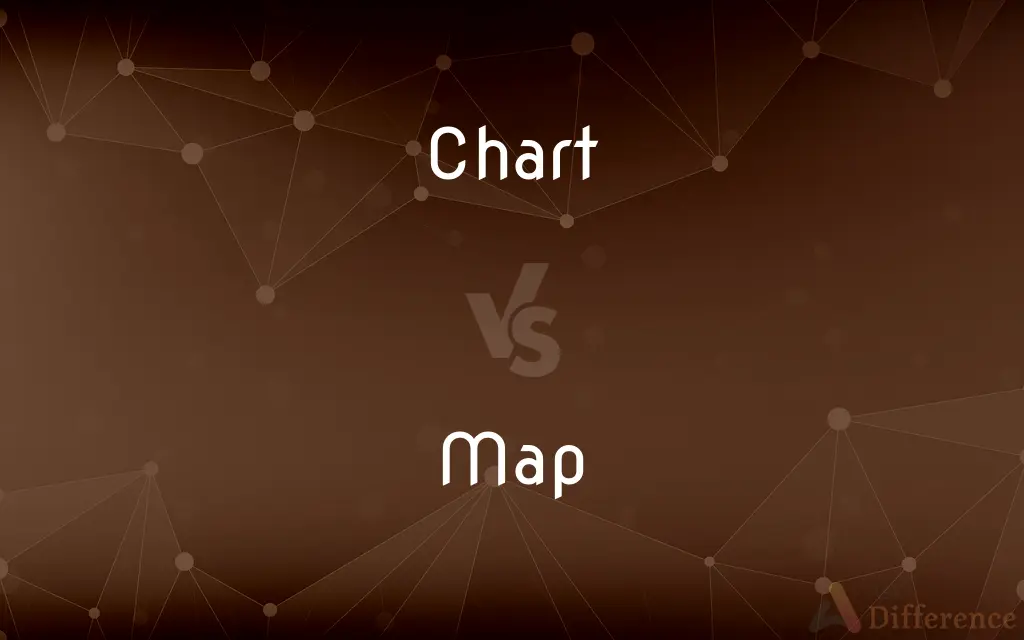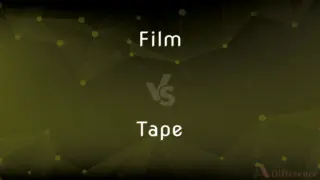Chart vs. Map — What's the Difference?
By Urooj Arif & Fiza Rafique — Updated on April 5, 2024
A chart is a graphical representation of data or information, while a map is a visual depiction of geographical areas, showing physical features, cities, and borders.

Difference Between Chart and Map
Table of Contents
ADVERTISEMENT
Key Differences
Charts are tools used to visualize data, making complex information easier to understand through the use of diagrams, graphs, and tables. They are versatile, used in various fields like finance, science, and education to depict trends, patterns, or relationships. On the other hand, maps represent physical and political features of geographical areas, providing a spatial understanding of places. Maps are essential for navigation, planning, and illustrating geographical concepts, differing from charts by their specific focus on geography.
While charts can be dynamic, reflecting changes in data over time with updates for accuracy, maps may also be updated, but typically to reflect changes in physical landscapes or political boundaries. This highlights a fundamental difference: charts are primarily about data visualization, whereas maps are about geographical representation.
Charts encompass a wide range of formats, including pie charts, bar graphs, and flowcharts, each designed to present data in a way that highlights specific aspects like distribution, comparison, or process. Maps, however, specialize in depicting geographical data, including topographical maps, political maps, and thematic maps, each focusing on different geographical details.
The creation of a chart involves selecting the appropriate type to effectively communicate the intended data or message. This requires an understanding of the data's nature and the audience's needs. Creating a map, however, involves geographical surveying and analysis, requiring precision in representing spatial relationships accurately.
Understanding charts and maps is crucial in different contexts; charts are indispensable in data analysis, decision-making, and presenting information, while maps are vital for understanding geographical locations, planning routes, and studying physical or political landscapes.
ADVERTISEMENT
Comparison Chart
Purpose
Visualizes data or information through various graphical formats.
Depicts geographical areas, showing features like terrain, cities, and borders.
Use
Used in finance, science, education, etc., to illustrate trends, patterns, or relationships.
Used for navigation, planning, and illustrating geographical concepts.
Types
Pie charts, bar graphs, line charts, flowcharts, etc.
Topographical, political, thematic maps, etc.
Focus
Data visualization and interpretation.
Geographical representation and navigation.
Creation
Based on data analysis and intended message, selecting appropriate graphical representation.
Involves geographical surveying and analysis, focusing on accuracy in spatial depiction.
Compare with Definitions
Chart
A visual representation of data designed to make complex information easily understandable.
The financial report included a pie chart showing the company's revenue sources.
Map
Crucial for navigation and planning, especially in unfamiliar territories.
Tourists relied on a city map to find major attractions.
Chart
Essential for presenting statistical data in a clear, concise manner.
The research paper used several bar charts to present the survey results.
Map
A depiction of geographical areas that shows physical and political features.
The explorer used an ancient map to locate the hidden city.
Chart
Can be used to compare different sets of data over time.
A line chart was used to depict the sales growth over the past year.
Map
Can illustrate specific themes like climate, population density, or economic activities.
A thematic map showed the predominant crops grown in each region.
Chart
Often found in educational materials to illustrate key concepts.
The textbook featured a flowchart explaining the photosynthesis process.
Map
Updated to reflect changes in geography or political boundaries.
The new edition of the world atlas included updated maps with recent country borders.
Chart
Versatile in format, tailored to the nature of the data and the audience.
The presentation used a scatter plot to show the correlation between two variables.
Map
Employed in various fields, including geography, urban planning, and environmental science.
The environmental study used topographical maps to analyze watershed patterns.
Chart
A chart is a graphical representation for data visualization, in which "the data is represented by symbols, such as bars in a bar chart, lines in a line chart, or slices in a pie chart". A chart can represent tabular numeric data, functions or some kinds of quality structure and provides different info.
Map
A map is a symbolic depiction emphasizing relationships between elements of some space, such as objects, regions, or themes. Many maps are static, fixed to paper or some other durable medium, while others are dynamic or interactive.
Chart
Make a map of (an area)
Cook charted the coasts and waters of New Zealand
Map
A representation, usually on a plane surface, of a region of the earth, intended primarily to provide information about the relative location or nature of features within that region.
Chart
(of a record) sell enough copies to enter the music charts at a particular position
The record will probably chart at about No. 74
Map
A similar representation of a region of the sky or of a celestial object
A map of the constellations of the southern hemisphere.
Chart
A map showing coastlines, water depths, or other information of use to navigators.
Map
Something that suggests such a representation, as in clarity of representation
A map of the human genome.
Chart
An outline map on which specific information, such as scientific data, can be plotted.
Map
(Mathematics) The correspondence of elements in one set to elements in the same set or another set.
Chart
A sheet presenting information in the form of graphs or tables.
Map
(Slang) The human face.
Chart
See graph1.
Map
(Genetics) A genetic map.
Chart
Often charts A listing of best-selling recorded music or other items
A hit single that reached number 3 on the charts.
Map
To make a map of.
Chart
To make a chart of.
Map
To depict as if on a map
Grief was mapped on his face.
Chart
To plan (something) in detail
Is charting a course to destruction.
Map
To explore or make a survey of (a region) for the purpose of making a map.
Chart
To be ranked on a chart of best-selling items
A song that charted at the number one position last week.
Map
To plan or delineate, especially in detail; arrange
Mapping out her future.
Chart
A map.
Map
(Genetics) To locate (a gene or DNA sequence) in a specific region of a chromosome in relation to known genes or DNA sequences.
Chart
A map illustrating the geography of a specific phenomenon.
Map
(Mathematics) To establish a mapping of (an element or a set).
Chart
A navigator's map.
Map
A visual representation of an area, whether real or imaginary, showing the relative positions of places and other features.
A map of Australia, a map of Lilliput
Chart
A systematic non-narrative presentation of data.
Map
A graphical or logical representation of any structure or system, showing the positions of or relationships between its components.
A map of the Earth's magnetic field
Chart
A tabular presentation of data; a table.
Map
(mathematics) A function. Category:en:Functions
Let be a map from to
Chart
A diagram.
Map
(entomology) Any of various nymphalid butterflies of the genera Araschnia (especially, Araschnia levana) and Cyrestis, having map-like markings on the wings.
Chart
A graph.
Map
The face.
Chart
A record of a patient's diagnosis, care instructions, and recent history.
I snuck a look at his chart. It doesn't look good.
Map
An imaginary or fictional area, often predefined and confined, where a game or a session thereof takes place.
I don't want to play this map again!
Chart
A ranked listing of competitors, as of recorded music.
They're at the top of the charts again this week.
Map
(computing) associative array.
Chart
A written deed; a charter.
Map
(transitive) To represent by means of a map.
This large atlas maps the whole world in very great detail.
Figure 3 maps the pressure distribution within the human circulatory system.
Chart
Synonym of coordinate chart.
Map
(transitive) To create a map of; to examine or survey in order to gather information for a map.
The team is mapping the route of the new railway line.
The space probe is mapping the Earth's gravitational field.
This equipment is designed to map the neurons of the human brain in three dimensions.
Chart
(transitive) To draw a chart or map of.
Chart the seas
Map
To have a direct relationship; to correspond.
This doesn't map to my understanding of how things should work.
Chart
(transitive) To draw or figure out (a route or plan).
Let's chart how we're going to get from here to there.
We are on a course for disaster without having charted it.
Map
To create a direct relationship to; to create a correspondence with.
Chart
(transitive) To record systematically.
Map
To act as a function on something, taking it to something else.
maps to , mapping every to .
Chart
To appear on a hit-recording chart.
The song has charted for 15 weeks!
The band first charted in 1994.
Map
To assign a drive letter to a shared folder.
Chart
A sheet of paper, pasteboard, or the like, on which information is exhibited, esp. when the information is arranged in tabular form; as, an historical chart.
Map
A representation of the surface of the earth, or of some portion of it, showing the relative position of the parts represented; - usually on a flat surface. Also, such a representation of the celestial sphere, or of some part of it.
Chart
A map; esp., a hydrographic or marine map; a map on which is projected a portion of water and the land which it surrounds, or by which it is surrounded, intended especially for the use of seamen; as, the United States Coast Survey charts; the English Admiralty charts.
Map
Anything which represents graphically a succession of events, states, or acts; as, an historical map.
Thus is his cheek the map of days outworn.
Chart
A written deed; a charter.
Map
To represent by a map; - often with out; as, to survey and map, or map out, a county. Hence, figuratively: To represent or indicate systematically and clearly; to sketch; to plan; as, to map, or map out, a journey; to map out business.
I am near to the place where they should meet, if Pisanio have mapped it truly.
Chart
To lay down in a chart; to map; to delineate; as, to chart a coast.
Map
A diagrammatic representation of the earth's surface (or part of it)
Chart
A visual display of information
Map
A function such that for every element of one set there is a unique element of another set
Chart
A map designed to assist navigation by air or sea
Map
Make a map of; show or establish the features of details of;
Map the surface of Venus
Chart
Make a chart of;
Chart the territory
Map
Explore or survey for the purpose of making a map;
We haven't even begun to map the many galaxies that we know exist
Chart
Plan in detail;
Bush is charting a course to destroy Saddam Hussein
Map
Locate within a specific region of a chromosome in relation to known DNA or gene sequences;
Map the genes
Chart
Represent by means of a graph;
Chart the data
Map
Plan, delineate, or arrange in detail;
Map one's future
Map
Depict as if on a map;
Sorrow was mapped on the mother's face
Map
To establish a mapping (of mathematical elements or sets)
Common Curiosities
Can charts be used for geographical data?
Yes, charts can represent geographical data, like population growth across different regions, but they do so through data visualization techniques rather than spatial representation.
Are all maps spatially accurate?
Most maps aim for spatial accuracy, but some, like schematic maps, prioritize clarity and ease of understanding over exact scale or distances.
What kind of chart is best for showing trends over time?
Line charts are particularly effective for showing trends over time, as they can clearly depict changes in data points across a continuous scale.
How do digital maps differ from traditional printed maps?
Digital maps can be more easily updated and often offer interactive features, allowing users to zoom in/out and access detailed information about specific locations.
What is the main difference between a chart and a map?
The main difference is their purpose: charts visualize data or information graphically, while maps depict geographical areas and features.
Do maps always represent real places?
Most maps represent real places, but there are fictional maps created for stories, games, and theoretical scenarios.
Why are thematic maps important?
Thematic maps are important because they provide insights into specific subjects, such as climate patterns or political leanings, by highlighting spatial distributions and variations.
Can a map be considered a type of chart?
While maps and charts serve different primary purposes, some argue that maps are a specialized form of chart focusing on geographical representation.
How are charts and maps updated?
Charts are updated based on new data and analyses, while maps are updated to reflect geographical or political changes, often through surveying and research.
What skills are necessary to create charts and maps?
Creating charts requires skills in data analysis and graphical design, while map-making (cartography) involves geographical knowledge, precision in spatial representation, and often, GIS (Geographic Information Systems) expertise.
Share Your Discovery

Previous Comparison
Firm vs. Stern
Next Comparison
Film vs. TapeAuthor Spotlight
Written by
Urooj ArifUrooj is a skilled content writer at Ask Difference, known for her exceptional ability to simplify complex topics into engaging and informative content. With a passion for research and a flair for clear, concise writing, she consistently delivers articles that resonate with our diverse audience.
Co-written by
Fiza RafiqueFiza Rafique is a skilled content writer at AskDifference.com, where she meticulously refines and enhances written pieces. Drawing from her vast editorial expertise, Fiza ensures clarity, accuracy, and precision in every article. Passionate about language, she continually seeks to elevate the quality of content for readers worldwide.
















































